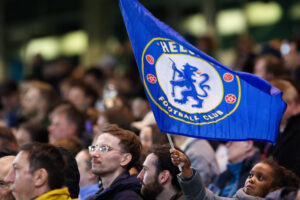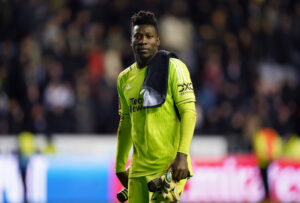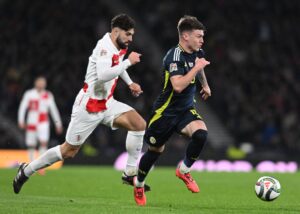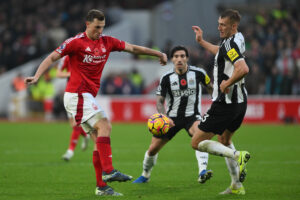Manchester United’s last match saw them advance to the FA Cup semi-finals after defeating Brighton & Hove Albion. Their most recent Premier League match was a terrific victory over Liverpool. However, it’s the Red Devils’ failure to defeat Sevilla in the Champions League that still weighs heavily on the minds of supporters. Jose Mourinho’s team looked devoid of life against the Spanish side, never truly imposing themselves on the match. His defend-first tactics failed him, which sparked outrage from fans desperate for attacking football. Defending is a generally accepted practice when Manchester United are winning. Yet, the hapless way in which they lose aggravates the fans. If Mourinho would consider changing formation, he may be able to get the best of both worlds.
Changing Formation Could Solve Manchester United’s Problems
Manchester United’s attack has become stagnant in recent weeks. They frequently ran out of ideas outside of trying to counter-attack. This lead to their uninspired performances in both legs against Sevilla. Mourinho’s tactics are partially to blame, however, Manchester United’s attackers all demonstrate similar tendencies on the field. Coupling these two factors explains why the Red Devils play with much more rigidity than their Premier League rivals. Observe the following player positioning charts from WhoScored:
 This is Manchester City’s average player positions from their 1-0 victory over Chelsea on March 4th. Pep Guardiola is certainly more offensive-minded compared to Mourinho. However, a player’s average position over 90 minutes will be influenced by his habits on the pitch. What’s important to notice here is the usage of triangles in their setup. No player, barring Ederson (31), has less than three viable passes at their disposal. In attack, their spacing permits each player to make runs into multiple areas; which allows a subsequent run from another player. Defensively, they are already in a strong formation should they lose possession. The only space to play a long ball is behind Oleksandr Zinchenko (35) and Kyle Walker (2). Compare that with Manchester United’s 2-1 loss to Sevilla:
This is Manchester City’s average player positions from their 1-0 victory over Chelsea on March 4th. Pep Guardiola is certainly more offensive-minded compared to Mourinho. However, a player’s average position over 90 minutes will be influenced by his habits on the pitch. What’s important to notice here is the usage of triangles in their setup. No player, barring Ederson (31), has less than three viable passes at their disposal. In attack, their spacing permits each player to make runs into multiple areas; which allows a subsequent run from another player. Defensively, they are already in a strong formation should they lose possession. The only space to play a long ball is behind Oleksandr Zinchenko (35) and Kyle Walker (2). Compare that with Manchester United’s 2-1 loss to Sevilla:

There are many notable differences between the two. Primarily, Manchester United’s defensive players are all in the defensive half; disconnected from the offensive players in the attacking half. Additionally, all attacking players occupy virtually the same space. Any forward pass is therefore into a crowded area and will likely result in dispossession. Any pass or runs into space behind defenders can only go wide, isolating the winger or fullback. Defensively, wing-backs are alone against wingers, which then draws centre-backs out of position. Switching to a 3-4-2-1 formation could solve these problems.
In Defence
A switch to a 3-4-2-1 formation may seem like a primarily attacking thought. However, based on Manchester United’s current roster, said switch would also improve the team defensively. It would be able to hide individual players’ defensive frailties while improving the team’s overall structure.
In a three-back formation, Victor Lindelöf (the best ball-playing centre-half at Mourinho’s disposal) would occupy the central role. The Swede has struggled in one-on-one situations this season but he is excellent at reading the play and a very vocal presence at the back. If he were to be flanked by stronger ball-winners (such as Eric Bailly and Chris Smalling) his weaknesses would be protected and Manchester United would be more structured with Lindelöf commanding the back-line.
The addition of a third centre-back would also aid the issues defending the wings. Ashley Young and Antonio Valencia have exceeded expectations as everyday full-backs. However, they do at times struggle when isolated in wider areas. This then pulls a centre-back out of position to help at the edge of the box. A snowball effect then ensues as Nemanja Matic is pulled much too deep into the back line, the central midfielders struggle to maintain possession, the attackers disconnect from the play and Manchester United are ultimately pinned in their own end. An extra centre-back would provide cover centrally, occupying the space that Matic habitually recedes into. Matic would then be able to track the most advanced midfielder from the opposition – a duty Paul Pogba frequently neglects. The Frenchman could then focus on ball retrieval and initiate linkup play and counter-attacks with the strikers.
In Attack
The 3-4-2-1 formation would also improve Manchester United’s spacing going forward, while simultaneously playing into the forwards’ habit to play centrally. Starting from the back, Lindelöf is an excellent passer of the ball, both grounded or aerially. Matic would take up position further forward, bridging the gap between strikers and defenders. An opposing midfielder would be forced to pay attention to Matic, creating more pockets of space for Pogba to occupy. The 3-4-2-1 eliminates the presence of a third central midfielder; this eliminates congestion centrally and gives Pogba more freedom of movement without occupying someone else’s space.
The flanking centre-backs would push wider while in possession. In turn, Valencia and Young would start attacks in the opponent’s half as opposed to dropping back to receive the ball. Opposing defenders would be drawn wide to quash the threat of two former wingers – who combine for 139 Premier League assists – delivering crosses. Drawing wing-backs away has the same common goal as eliminating a midfielder: space for attackers centrally. Which is where the 3-4-2-1 excels.
Romelu Lukaku will spearhead the attack. The two players behind the Belgian, however, will have specific jobs to improve fluidity. Marcus Rashford or Anthony Marital would play one role. They have terrific pace, prolific dribbling skills and instincts from playing as a striker. Their success would come from running beyond Lukaku, playing off his flick-ons and pulling defenders deeper into their own half. Alexis Sanchez or Jesse Lingard would be the other player. They are more astute when the ball comes to their feet from the midfielders. Rather than run beyond defenders, Sanchez and Lingard prefer running at them. Beating them with short quick passes can take a defender completely out of play and create the room for a through-ball to Rashford or Martial.
The Last Word
Having given him a contract extension, Manchester United clearly believe in Jose Mourinho. But he will also never deviate from his structured, defensive tactics despite having a wealth of offensive weapons at his disposal. If the Portuguese would consider changing formation to a 3-4-2-1, a system that comfortably won the Premier League just last season, Mourinho would be able to find the structure he so desperately craves. However, in the current formation, his players’ natural instincts result in crowding, detached play and ultimately an exit from the Champions League. A new system could reinvigorate the team and provide dynamic talents with the freedom that they deserve.
Main Image Credit:






